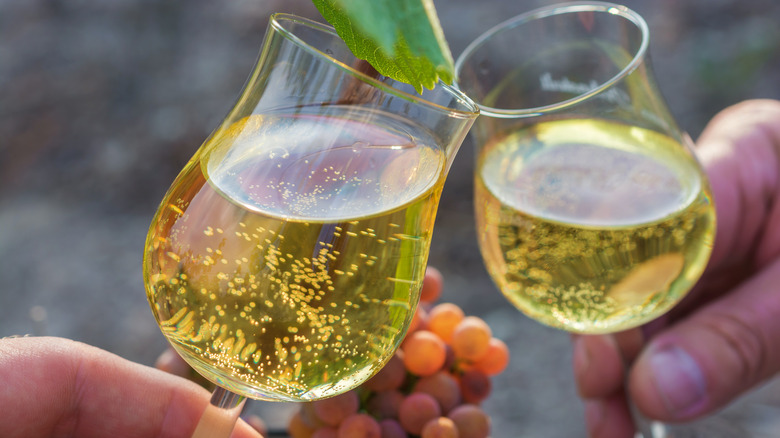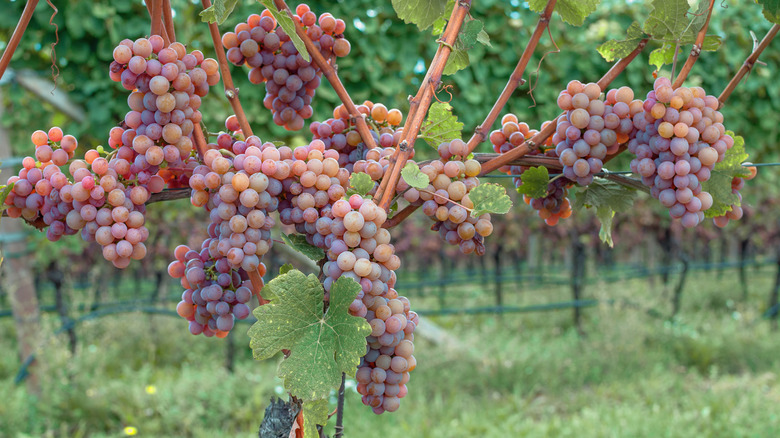What Makes Gewürztraminer Wine Unique?
As far as we know, the oldest remains of wine found thus far date back to the Neolithic period between 5400 and 5000 B.C. at Hajji Firuz Tepe in what is modern-day Iran, per Arena Flowers. That means we have been indulging in wine for thousands of years and had that time to cultivate thousands of different kinds of grapes and ferment innumerable bottles of wine.
There are a lot of different elements when it comes to winemaking — red vs. white vs. rosé, American vs. French oak, and dry vs. semi-sweet, just to name a few. No one, even the most intelligent, educated, and well-renowned winemakers, knows every single wine and clone of wine in the world. No one can know "everything" about wine, which makes the subject so exciting! There is always something new to learn, a new method to try, and a new kind of glass to drink out of. Most of the time, you'll find that people prefer dry wines over sweet ones, but they also come with nuances and complexities. Pinot gris, riesling, and moscato are all popular white, sweet wines, but a sweet wine that is often overlooked is the gewürztraminer.
What is Gewürztraminer?
Gewürztraminer is a wine grape grown all over the world, but is originally found in the Trentino-Alto Adige region in Northern Italy and is now widely grown in the Alsace region in France, as well as in Germany (via Wine Tourism). According to Tastings, the name "gewürztraminer" translates to "spicy traminer." Traminer is another wine clone that gewürztraminer is related to. The gewürztraminer grape appears pink or even dark-skinned, but it doesn't produce a natural rosé — instead, the white wine is made from berries that take on a yellow-hued color. The wine made from this grape tends to lean more towards the sweet side of life with producers purposefully bottling it with residual sugar.
Like many other wine varieties, the gewürztraminer ripens and is ready for harvest sometime between the months of September and October. Wine Magazine explains that the gewürztraminer tends to experience bud break earlier than most other wine varieties, but the vines are particularly sensitive to the damp, disease, and frost. TyTy says that the gewürztraminer prefers to grow in sunny climates and reminds those admiring the grape vines that although the wine produced is white, the berry itself can be fairly dark in color and take on purple hues more commonly associated with red-wine grapes.
Tasting notes and food pairings
When it comes to drinking gewürztraminer, you have quite a few options. Gewürztraminer tends to be sweeter than dry whites you might be familiar with such as sauvignon blanc, chardonnay, or albariño. But different wine producers will adjust the level of sugar they leave in the wine based on their own preferences, so just because you thought one gewürztraminer was too sweet for you doesn't mean that all of them will be. Food & Wine describes the wine as having flavors of lychee fruit, pineapple, stone fruit, and a complex but delicious blend of spice notes like ginger. With low acidity, full body, and robust aromas which can be enjoyed dry or sweet, the gewürztraminer is a particular treat to pair with food. The wine is absolutely delicious by itself, but food and wine pairings are half of the fun of wine drinking.
According to Wine Folly, gewürztraminer should be served at 43 degrees F (6 degrees C) and works beautifully with Middle Eastern dishes because of their focus on smoked meats, dried fruit, and nuts. Meats like duck, chicken, pork, bacon, shrimp, and crab are also highly recommended, but the best thing to pair gewürztraminer with are spices. Though the wine is fairly fruity, its complexity comes from the subtle spice characteristics laced throughout it, and these characteristics are further enhanced when eaten with foods seasoned with cayenne pepper, ginger, clove, cinnamon, turmeric, coriander, cumin, and more. Gewürztraminer is excellent with curries and its sweetness helps to offset spicy foods.
Riesling vs. Gewürztraminer
One of the wines that gewürztraminer is commonly compared to is the riesling. Both white wines are popularly grown in Germany and tend to be made off-dry or semi-dry (though there are winemakers that leave no residual sugar after fermentation, creating a bone-dry wine). Bordeaux-Undiscovered says that though gewürztraminer and riesling are alike in a myriad of ways, riesling tends to be the most popular among the two, this could be due to the fact that riesling tends to be higher in acidity and appeals to drinkers that prefer a little sharpness to balance out the sweet.
According to A Wine Story, both gewürztraminer and riesling, along with pinot gris and muscat, are considered a part of the noble grape varieties of Alsace. But the gewürztraminer looks dark gold in color and is extremely rich and lush on the palate with tropical flavors, while riesling looks pale in comparison and is zestier with floral notes of jasmine and peach. You'll likely find riesling as a more common bottle at the dinner table, but if you enjoy off-dry wines or are looking to explore more white varietals to expand your palate, give a gewürztraminer a try!



